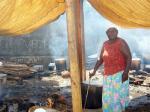Macron Honors Touissant Louverture, but Leaves Much Unsaid
French President Emmanuel Macron recently visited the French prison where revolutionary leader, Touissant Louverture died, having been kidnapped during what were supposed to be negotiations. Louverture had wanted equal rights for Haitians which the French would not accept. Jean-Jacques Dessalines subsequently determined the French could not be trusted and must be defeated militarily, which they were. This is the first time a French leader has paid tribute to Louverture. It is just the first step on what would be a long road to reconciliation and justice. The full New York Times article follows.









